k1K5/2n5/8/8/b7/1R6/8/8
W : Kç8 Rb3
B : Ka8 Ba4 Nç7
+ (2+3)
1 Rb6! (threatens Kxc7) Nb5 2 Ra6+ Na7+ 3 Kc7 Be8 (Bishop must remain on this diagonal to be able to play Nb5 or NC6 after Rb6) 4 Ra3 !!
4 Ra1? Bg6!
4 Ra2? Ba4!
4 ... Ba4 5 Ra2 (reciprocal zugzwang) and here several branches that I let you shake
5 ... Bb3
5 ... Nb5+
5 ... Be8
5 ... Bd1 which remains the longest variation
The following position is an end of a study by Afek
3 - White to play and draw
Yochanan AFEK
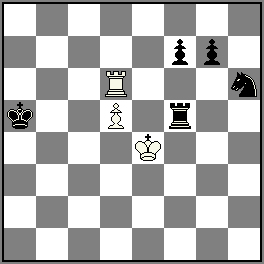
8/5pp1/3R3n/k2P1r2/4K3/8/8/8
W : Ké4 Rd6 Pd5
B : Ka5 Rf5 Nh6 Pf7g7
= (3+5)
(Note the slightly more crowded starting position: White: Ke4, Re7, pa6, b7, d5 and d6 Black: Ka7, Rf5 and f6, Ng8, pf7 and g7)
And now, the exercise for next session which will be held in just under 3 weeks time on 14 May
4 - exercise : White to play and draw
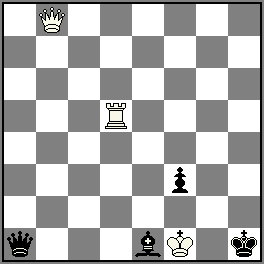
1Q6/8/8/3R4/8/5p2/8/q3bK1k
W : Kf1 Qb8 Rd5
B : Kh1 Qa1 Bé1 Pf3
(3+4)
It doesn't smell too good for white, but there is surely the move that ends the multiple dangers of the position
5 - Game of the day K - K
1 d4 Nf6 2 c4 g6 3 Nc3 d5 4 Nf3 Bg7 5 Qb3
russian variation
5 ,,, dc 6 Qxc4 0-0 7 e4 Bg4 8 Be3 Nfd7 9 Rd1 Nc6 10 Be2 Nb6 11 Qc5 Qd6 12 e5
12 Qxd6 Nb5 d5 0-0 and finally h3 with the famous Botvinnik - Fischer game : Bxf3 13 gf Rfd8 14
d5 Ne5 15 Nb5 Qf6 16 f4 Nd7 17 e5 Qxf4 ! And if 18 Qxb6 ?? Qe4 ! 19 f3 Qh4+ and Qb4+
12 ... Qxc5 13 dc Nc8
13 ,,, Nd7 ! 14 h3 Be6 15 Ng5 Ndxe5 16 Nxe6 (16 f4 Nc4 17 Bc1 Na3) fe 17 f4 Nf7 18 Bc4 e5
19 0-0 ef 20 Bxf4 Rac8 21 Be1 Rcd8 22 Bxc7 (22 Rxd8 Ncxd8) Rxd1 23 Rxd1 and Black plays
Kg7 and Nfd8
A bit tight but quite playable !
14 h3 Bxf3 15 Bxf3 Bxe5 16 Bxc6 bc 17 Bd4 Bf4 18 0-0 a5 ?
18 ... e5 19 Be3 Bxe3 20 fe Ne7 21 Rd7 Nf5 22 Rxc7 Rfc8 23 Rd7 Rd8 24 Rfd1 Rxd7 25 Rxd7 Nxe3 26 Rc7 Rb8! 27 b3 Rd8 K - Timman
19 Rfe1 a4 ?! 20 Re4 Bh6 21 Be5 a3 22 b3 Na7 23 Rd7 Bc1
A scam attempt
24 Rxc7 Bb2 25 Na4 Nb5 26 Rxc6!
pc5 now has a clear path
26 ... Rfd8 27 Rb6 Rd5
A sweeper trap
28 Bg3! Nc3 29 Nxc3 Bxc3 30 c6 Bd4 31 Rb7 resigns
To attack the aperitif, we discover the gnu which is an incestuous crossing between the Knight and the Camel
6 - h#2 with Gnu and twin
Valerio AGOSTINI
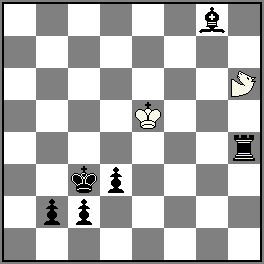
6b1/8/7G/4K3/7r/2kp4/1pp5/8
W : Ké5 Gnh6
B : Kç3 Rh4 Bg8 Pd3b2ç2
h‡2 (2+6)
b)Pc2->d2
Gn=Gnu : Knight (1+2) or Camel (1,3)
Check out this problem, it's very accessible
A Frenchman tackling a genre with an English name is worth noting.
7 - h#2 Take&Make 2 solutions
Pierre TRITTEN
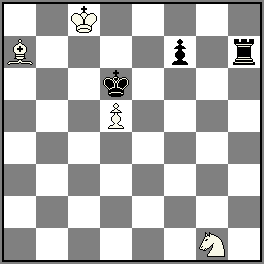
2K5/B4p1r/3k4/3P4/8/8/8/6N1
W : Kç8 Ba7 Ng1 Pd5
B : Kd6 Rh7 Pf7
h‡2 (4+3)
Take & Make :
a capture must necessarily be followed by a move without capture of the capturing piece adopting the step of the captured piece
Small indication: the f7-pawn is an anti-demolition since it cannot be taken at Make
And for the digestive, a Peter Harris
8 - h#4,5 with twin Köko Circé
Peter HARRIS
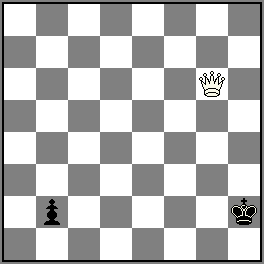
8/8/6Q1/8/8/8/1p5k/8
W : Qg6
B : Kh2 Pb2
h‡4,5 (1+2)
b)Kh2->g5
Köko : at the end of a move, a piece must be in contact with another
Circé : a captured piece is reborn on its original square
Pure Harris. He must be in his eighties and you can feel that he is still full of imagination.
An example to us all! Hats off to Mr Harris.
We look forward to seeing you on 14 May.
The electronic and more complete report of the Master, is of course below. Thanks to him.
Good reading
Yours sincerely
le greffier
Add a comment